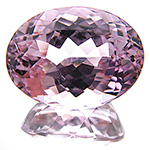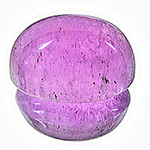Kunzite
The pink gemmy variety of the mineral spodumene. Other varieties are the green hiddenite and the rarely cut colourless to light yellow triphane.

Origin of name: after George F. Kunz [1856-1932], American mineralogist, gemmologist and vice president of Tiffany, New York, who firstly described lilac gem spodumene from Pala, California, in 1903
Synonyms and trade names: none
Can be confused with: other pink and lilac gems like morganite, rubellite, rose quarz, rose de france coloured amethysts etc.
Localities: the most important sources of gem kunzite are Afghanistan, Pakistan, USA and Brazil. Other, less important sources are Madgascar, Mocambique, Ethiopia, Namibia and Sri Lanka.

Rare kunzite cabochon from Pakistan
Handling: kunzite cleaves perfectly and is very sensitive to pressure. Moreover it is sensitive to heat and must be unset before soldering. Never clean ultrasonically! Sensitive to fluoric acid. Temperatures of 150°C and more may lead to colour changes. Colours of irradiated and/or heat treated kunzite may fade upon prolonged exposure to sunlight or strong artificial light
 Deutsch
Deutsch